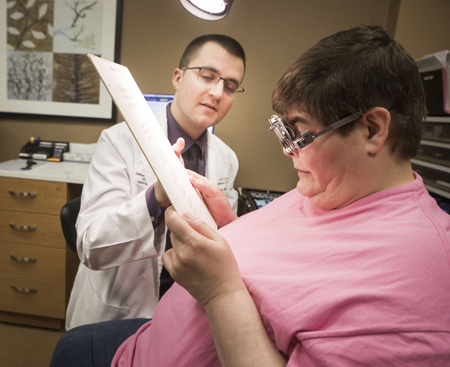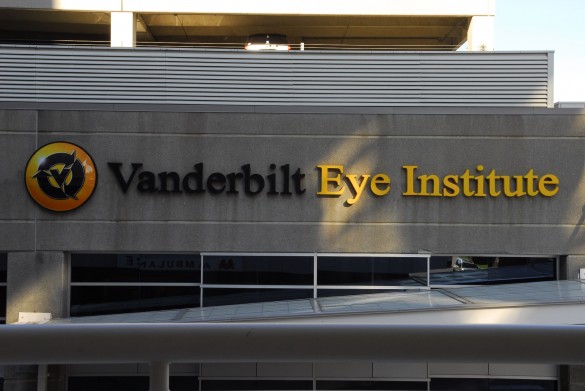by Jessica Pasley
When Josh Robinson, OD, chose to specialize in low vision optometry, he was certain of one thing — his services would have a big impact on his patient population — and it is proving to be true.

Robinson joined Vanderbilt in fall 2018 facing a nearly 10-month backlog of low-vision cases.
Not anymore.
“There was really an outstanding need within our department and within the community for services like this,” said Robinson, instructor in Clinical Ophthalmology and Visual Sciences at Vanderbilt Eye Institute. “There is no other comprehensive, multidisciplinary, low-vision program like what I am trying to build anywhere in Middle Tennessee.
“There has been and will continue to be a dramatic increase in the number of individuals who need these services, and, at the same time, there is a manpower shortage for people like me who have the training and dedicated time to provide low-vision services.”
Today Robinson’s daily clinic sees more than 25 new patients a week from not only Tennessee but also Kentucky, Alabama, Georgia, Virginia, Mississippi, North Carolina and South Carolina.
Low vision refers to a vision impairment or loss that cannot be corrected to normal levels with glasses, contacts or medical/surgical interventions. Causes for low vision include both medical and neurological diagnoses including macular degeneration, glaucoma, diabetic retinopathy, retinitis pigmentosa, retinopathy of prematurity, eye injuries and stroke, among many others.
Although geriatric patients make up the majority of his patient volume, he sees a robust pediatric population as well.
“I begin seeing patients starting in kindergarten,” he said. “There are a lot of young children and teens with inherited retinal conditions that impact their ability to attend school, drive, get into college and be independent.
“Patients often come to me after being told there is nothing more that can be done. But for many families our clinic can potentially mean keeping the door open to get a driver’s license for their child,” he explained. “For my adult patients, it could mean maintaining a level of employment and independence, while my retired patients may be able to read a menu, the Bible or watch TV.
“I chose this field because of the impact prescriptive devices and support can provide. I was exposed to this subspecialty as a student. I saw the impact his services had on patients and their quality of life.”
After graduating from optometry school in Chicago, Robinson completed an additional yearlong residency training program in low vision rehabilitation.
Now his clinic focuses on creating a personalized low-vision rehab plan that can include custom lenses, adaptive optical equipment or adaptive technology. Patients may be connected with occupational therapists or specialists trained in orientation and mobility and vocational rehabilitation. The individualized plan may also include social work and counseling referrals.
One of the biggest hurdles in low vision care is coverage of the prescription devices, said Robinson, which places a large burden on the patients for out-of-pocket expenses. One of the features of his clinic that sets him apart from other programs is funding to assist patients who meet the financial assistance criteria.
“Pulling in all of these disciplines helps individuals to be well equipped with the physical tools, technology and resources and to be empowered,” said Robinson. “We are able to provide much needed continuum of care and follow through. The focus is on patients not being limited by what vision they may have lost. They are able to maintain their identity and quality of life.”
Robinson will also begin implementing the clinical research arm of his practice that will dig deeper into low-vision rehabilitative strategies to offer better outcomes and treatment approaches.















